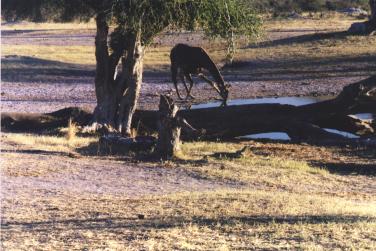Evolution
A few summary comments about evolution:
Evolution occurs because the genetic
code allows for variations and is not
error-free. Thus, one panda sometime in
history had -- by chance -- a slightly
enlarged radial sesamoid and there was
an evolutionary advantage to that, in
that this panda (and its offspring) survived
and reproduced more successfully.
For every random evolutionary advantage,
exaptation, or adaptation, there are many
failures. Remember the Opabinia --
it seems like five eyes (the better to see
you with) and a elephant-like trunk/mouth
(the better to eat you with) might be advantageous
traits. But, for some reason, this species
was not successful, and died out. The process
of evolution by definition must have
at least as many failures as successes: for
every random mutation that creates an enlarged
radial sesamoid there must also be a random
mutation that creates a smaller radial sesamoid.
Those lesser sesamoid pandas were evolutionary
disadvantaged and did not successful propagate
their genes.
Remember that Lamarck suggested that if giraffes
stretched their necks to get food then giraffe children
would be born with long necks. I said that the causality
was wrong, but not that the conclusion was wrong. It
may be that giraffes with longer necks are better
equipped to get more food, see predators come from
farther away, etc. In this case -- unlike the wing --
5% of a long neck, 10% of a long neck may have
been evolutionarily advantageous. In this case, giraffes
with longer necks might have been more successful
in reproducing their random mutation. Thus, over
time, children of giraffes would indeed be born with
longer and longer necks, as long as it remained an
evolutionary advantage. Thus, Lamarck's steps were
correct -- that giraffe children would be born with
longer necks -- but his causality was incorrect.
One might therefore ask why giraffes' necks aren't
longer than they are?
It may be that having necks that are really long is
an evolutionary disadvantage -- easier prey when drinking,
for example.

Photo by DET
Back
Back to Lecture 23 outline
Back to lectures page
Back to main course page
